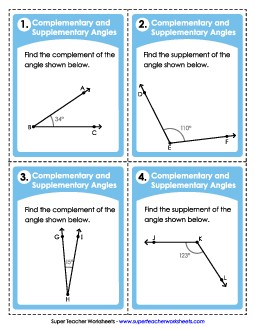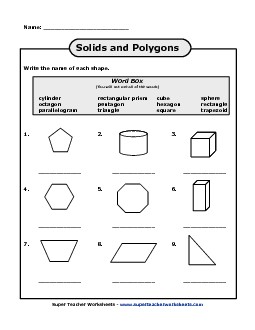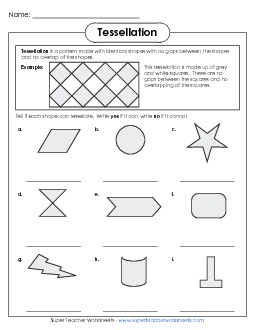Geometry Worksheets - Index

Identify, classify, and draw acute, obtuse, and right angles.
Angles (Measuring)Worksheets with practice problems for measuring angles with protractors.
Angles (Supplementary, Complementary, Vertical)On this page, you'll find several worksheets for calculating the measurements of supplementary, complementary, and vertical angles.
Area WorksheetsDetermine the area, or amount of space taken up, by the geometric shapes.
Area of TrianglesUse the formula a = 1/2 x (b x h) to calculate the area of triangles.
Flips, Slides, and Turns WorksheetsPractice sheets for shape movements. Examine the shapes to tell which were flipped, slid, or turned.
Ordered Pair WorksheetsPrintable worksheets for plotting and finding ordered pairs on a coordinate plane.
Perimeter WorksheetsAdd the sides to find the perimeters of the shapes.
Points, Lines, Segments, RaysLearn about lines, line segments, rays, points, parallel lines, intersecting lines, and perpendicular lines.
Polygon WorksheetsShapes for flat figures like rectangles, squares, triangles, hexagons, and parallelograms.
Radius, Diameter, and Circumference WorksheetsLearn about a circle's radius, diameter, circumference, and area.
Similar and Congruent Shapes WorksheetsWorksheets for learning about translation, rotation, and reflection of shapes.
Solid Shapes WorksheetsPrintable materials for teaching solid (3D) shapes like spheres, rectangular prisms, pyramids, cubes, and cones.
Solid Shapes Worksheets (Very Basic)This page has very basic printables on identifying solid shapes. Includes cubes, cones, rectangular prisms, and spheres. Recommended for grades Pre-K through 1st.
Surface Area WorksheetsDetermine the surface area of the cuboids (rectangular prisms) and other shapes.
Symmetry WorksheetsSymmetry worksheets, task cards, as well as cut-and-fold activities can be found on this page.
Tessellation WorksheetsLearn about geometric tessellations, or shapes that fit into each other to make a pattern.
Translation, Reflection, and Rotation WorksheetsWorksheets for learning about translation, rotation, and reflection of shapes.
Triangle TypesClassify triangles by sides (equilateral, scalene, and isosceles), and by angle (obtuse, acute, and right).
Volume WorksheetsWorksheets for calculating the volume of solids. Includes "counting cube" worksheets, as well as activities on using formulas to calculate the volumes of rectangular prisms, cones, pyramids, and spheres.



Geometry is a central part of elementary school math, typically introduced in the early grades with basic shapes and gradually progressing to more complex concepts by third to fifth grade. Students start by learning to recognize and name different types of shapes, such as squares, rectangles, circles, and triangles. As they advance, they explore more intricate topics like angles, including right, acute, and obtuse angles, and begin calculating area, volume, and perimeter. Understanding symmetry and tessellations introduces students to patterns and spatial reasoning, while the study of triangles lays the foundation for more advanced geometric principles, including types of triangles like equilateral, isosceles, and scalene.
Teachers use a variety of interactive classroom methods to make geometry engaging and accessible. For younger students, hands-on activities like building shapes with physical objects, drawing on graph paper, or using manipulatives like geoboards help them grasp the properties of different geometric figures. As students move on to more complex topics, they are introduced to tools like protractors and rulers for measuring angles and sides. Additionally, digital apps and games that focus on shape recognition, area calculation, and symmetry can make learning geometry fun and interactive. Word problems that involve calculating the perimeter of a fence or determining the area of a garden help students apply their geometry knowledge to real-life scenarios, strengthening their problem-solving abilities.
Understanding the core concepts of geometry is essential for students’ overall math proficiency and success in higher-level math courses. Geometry is not only foundational for advanced subjects like algebra and trigonometry but also plays a crucial role in fields like art, architecture, engineering, and computer science. Super Teacher Worksheets helps to master topics such as area, volume, and symmetry which equips students with the ability to solve practical problems, such as planning space in a room or creating patterns in design. Additionally, geometry fosters spatial reasoning and logical thinking, skills that are invaluable in both academic and everyday contexts. A strong understanding of geometry helps students build confidence in their math abilities and prepares them for future challenges. Challenge your students with STW's free geometry worksheets today.






